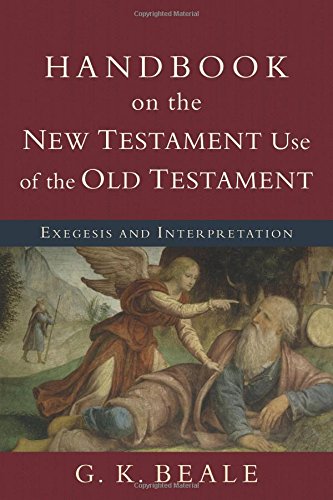Handbook on the New Testament Use of the Old Testament: Exegesis and Interpretation, by G. K. Beale (Baker Academic, 2012), 174 pages.
Beale is widely known for publishing extensively on the New Testament’s use of the Old. This work provides the student with a distilled outline of his entire exegetical method for interpreting the OT in the NT.
Note: This work is currently 50% off at WTSBooks.
Outline
In chapters 1 and 2, Beale introduces the reader to the discipline of Old in the New studies, surveying various interpretive and methodological developments. The specific layout of the exegetical methodology offered in this handbook is articulated in Chapter 3. The steps involved in this method move the interpreter from specific contextual considerations of both the New and Old Testament pericopes, to Jewish background studies, linguistic comparisons of the texts, and finally into the hermeneutical, theological, and rhetorical thrust behind the New Testament’s appropriation of the specific Old Testament text.
Chapter 4 provides twelve similar but distinct hermeneutical uses employed by the NT writers. Beale’s expansion of the more basic categories (i.e. analogy) may provide the exegete with the appropriate tools to properly handle the OT in the NT (i.e. indirect typology).
In chapter 5, Beale outlines five presuppositions held by the NT writers, in order to elucidate the NT writer’s particular hermeneutical use of the OT text. He believes these are all rooted in the OT. The presuppositions are corporate solidarity/representation, the church as true Israel with Christ as its corporate head, the unification of history by a sovereign plan, inaugurated eschatology, and the use of biblical history as the broad context to interpret earlier parts of Scripture (p. 53).
Chapter 6 gives a topical outline with specific volumes and resources within Jewish backgrounds, while chapter 7 includes a detailed example of the method using the example of Isaiah 22:22 in Revelation. 3:7.
Assessment
This book is welcome as a comprehensive (albeit, concise) handbook that teaches the student Beale’s method and teaches him or her about the resources required for the job. One of the most useful functions of the book is Beale’s extensive annotated bibliographies. He provides the various tools available to help one detect quotations and allusions (and there are many), as well as the sources to use for finding Jewish uses of the OT. For one newer to the field of OT in the NT, these bibliographical references are incredibly helpful.
The reader may be left longing for more treatment on the use of early and late Jewish backgrounds. Helpful works are recommended in this area [i.e. C. A. Evans, Ancient Texts for New Testament Studies: A Guide to the Background Literature (Peabody, MA: Hendrickson, 2005), 10–55]; however, more discussion regarding the proper assessment of the Jewish use of the OT would prove instructive for comparative study. For example, are the hermeneutical presuppositions of Jewish writers the same as the NT writers? Are their hermeneutical uses the same, or different? Does Beale view Jewish uses as primarily hermeneutical (e.g., his twelve categories), or technical (e.g., proem midrash)?
Beale’s limited discussion on some of the points may leave the reader longing for more; however, this methodological handbook is exegetically insightful and theologically stimulating. Whether the reader agrees with all of Beale’s nuances, this handbook will be a helpful resource for those interested in developing their exegetical capabilities and should be recommended material for anyone interested in biblical studies.
Buy it here at 50% off from WTSBooks.
For a fuller review see Todd’s published review for SWJT 56.2 or Warren’s review at the Logos Blog

